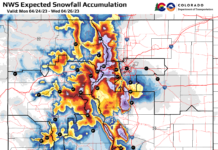by Nina Wood
By the time the volunteers gathered at the Sugarloaf Campground on the upper Williams Fork in July of 1989, the engineering, planning, and placement of building supplies had already been done. Starting in 1988, a plan had been created to construct a wheelchair-accessible boardwalk to cross the Williams Fork River and its marshlands.
That area is under the jurisdiction of the US Forest Service, but the project was an effort involving sponsors and volunteer efforts from several entities.
By the end of the day that July, the boardwalk was pretty much complete. Rails to guard wheels of the wheelchairs from rolling off the boardwalk were completed shortly thereafter, and the project was finished.
Eight feet wide and about 1500 feet long, it allowed the disabled access to an area not even a horse and rider could safety cross. Admittedly though, that part of Grand County isn’t exactly on a main route. Not far off CR3 at the east base of Ute Pass, except for the campground that went through years of closure with the invasion of the pine beetle, there wasn’t and isn’t any other destination there.
Almost no maintenance has been in the years since. Sadly and for several reasons, the boardwalk is on its way out. The years have proven creosote treated telephone poles used as pylons for the base were not appropriate for the wet and marshy environment. And as those have sunken into the soft ground, sections of the boardwalk have become detached from others. Boards have rotted and developed holes. A few have been replaced. But there have been changes in the districting of the USFS and tightening budgets. The end result is bit by bit as the boardwalk sections become unsafe, they are being removed without any plan to replace them. Eventually the goal is the elimination of all those creosoted telephone poles that remain more or less in place, putting contamination into the water of the river.









